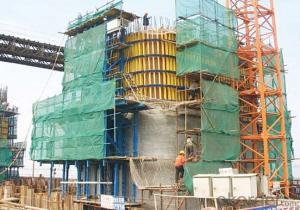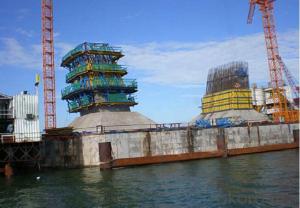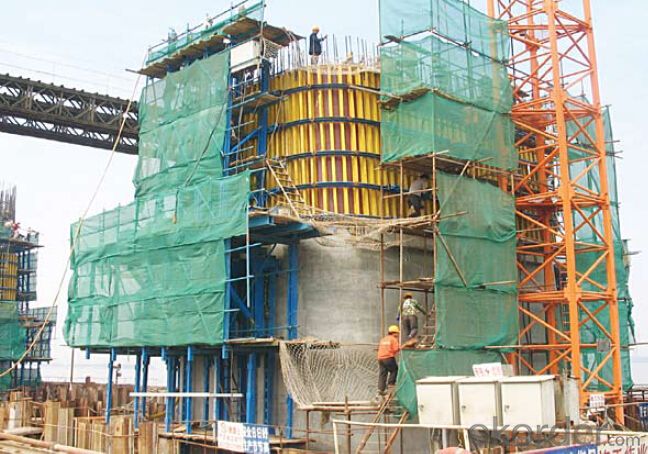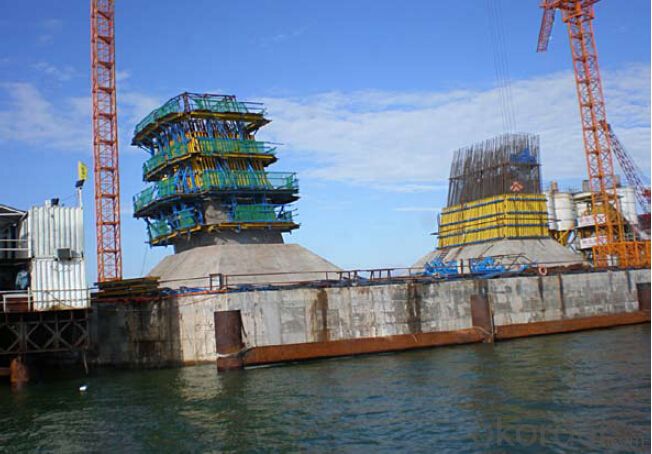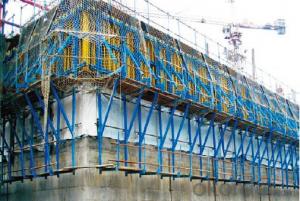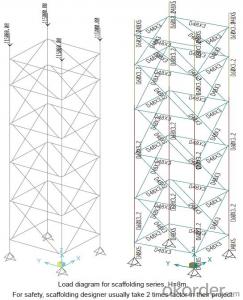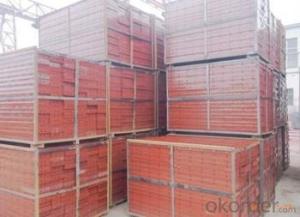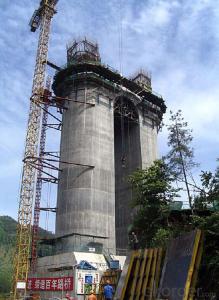Auto-climbing Bracket ACB100 for formwork and scaffolding system
- Loading Port:
- Tianjin
- Payment Terms:
- TT OR LC
- Min Order Qty:
- 50 m²
- Supply Capability:
- 1000 m²/month
OKorder Service Pledge
OKorder Financial Service
You Might Also Like
Auto-climbing Bracket ACB100 & ACB50
The power of the auto-climbing formwork is the hydraulic system, which includes the oil cylinder
and two commutators. The commutators can control the climbing of climbing rail and the bracket.
The steel rail and the bracket can inter-climbing, so the whole system will climb up steadily.
Cranes are not needed during the construction. It’s easy to operate, highly efficient and safe. It’s
the best choice for the construction of high buildings and bridges.
There are mainly two types of standard auto-climbing brackets, ACB-50 and ACB-100, the figure
means the push power of cylinder with unit of KN.
Characteristics:
◆ Perfect load bearing anchor system
Anchor system is the most important supporting part. The system is made of five parts shown
below. Thereinto, tensile bolt, V-climbing cone and washer can be taken out for reusing after the
concrete pouring finished.There are two kinds of anchor systems,A & B. A is matched with single
anchor shoe and B is matched with double anchor shoe.
◆ Crane-independent
Crane-independent forming, striking and climbing speeds up the work procedures on the
construction site and also makes them independent of each other. This means the planned
sequences can be maintained along with guaranteeing high productivity levels. The crane can
therefore be used for other tasks.
Hydraulic system is mainly made of two commutators,
oil cylinder and power distribution system.The
commutators can control the climbing of climbing rail
and bracket.
◆ High bearing capacity and safe
The stable working platforms are able to carry large loads, e.g. the storage of reinforcing steel
for the next climbing section. Generously-sized working platforms, the well thought-out design for
handling very high wind loads and the patented control function of the climbing mechanism are
some of the special details contained within the comprehensive safety concept.
◆ Platforms adjusted to suit the angle of inclination
The horizontal working areas thus created provide safe and comfortable conditions for
reinforcement work, shuttering and striking, concreting and finishing.
◆ The ACB formwork system can climb not only vertically but also slantways, the largest angle is
18 degrees.
◆ The system can climb up wholly or separately. The climbing process is steady, synchronous
and safe.
◆ The bracket will not fall to the ground until the construction is finished, the field will be saved
and the impacting breakage will be reduced (especially the panel).
◆ The system will furnish omnidirectional platform, the construction organizations don’t need to
set up additional operation platform.
◆ The error of structure construction is small and easy to correct.
◆ The climbing speed is fast, the construction course will be quickened.
◆ The formwork can climb itself and cleaning work can be done in the same situs , the used times
of tower crane will be greatly reduced.
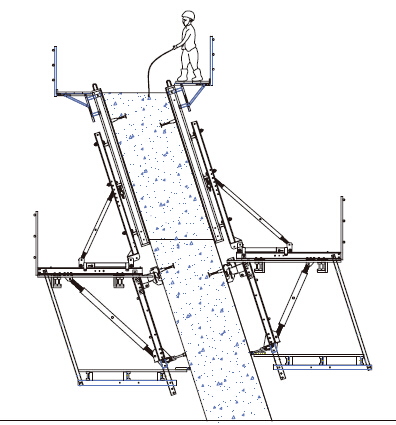
- Q: Can steel formwork be used for architectural concrete walls with complex geometries?
- Indeed, architectural concrete walls with complex geometries can indeed utilize steel formwork. The utilization of steel formwork bestows numerous advantages for such applications. Its remarkable durability enables it to withstand the force exerted by the concrete during the pouring and curing process. Additionally, steel formwork guarantees exceptional dimensional accuracy, ensuring that the concrete walls are constructed according to the desired complex geometries. Furthermore, steel formwork facilitates effortless customization and design flexibility. It can be effortlessly fabricated into a plethora of shapes and sizes, thereby empowering architects to create intricate and distinctive architectural concrete walls. Moreover, steel formwork endows the concrete with a smooth and uniform finish, resulting in visually pleasing walls. Moreover, steel formwork boasts reusability, thus rendering it a cost-effective choice for projects involving complex geometries. It can be disassembled and utilized for multiple projects, thereby reducing overall construction expenses. The ease of cleaning and maintenance of steel formwork further enhances its usability and longevity. To conclude, steel formwork emerges as an optimal selection for architectural concrete walls with complex geometries. It provides strength, durability, dimensional accuracy, customization options, and cost-effectiveness, thus making it a suitable solution for constructing visually appealing and structurally sound concrete walls.
- Q: Can steel formwork be used for elevated concrete slabs?
- Yes, steel formwork can be used for elevated concrete slabs. Steel formwork is known for its strength and durability, making it suitable for supporting the weight and pressure of concrete during construction. It provides a stable and rigid framework for pouring and shaping concrete, ensuring the formation of high-quality elevated slabs.
- Q: Can steel formwork be used for structures with high seismic resistance requirements?
- Yes, steel formwork can be used for structures with high seismic resistance requirements. Steel formwork is known for its strength, durability, and stability, which makes it suitable for withstanding seismic forces. It provides a rigid framework that can withstand lateral forces and vibrations caused by earthquakes. Steel formwork offers several advantages for structures with high seismic resistance requirements. Firstly, it provides a sturdy and reliable support system during the construction process, allowing for accurate placement and alignment of reinforcement and concrete. This ensures that the structural elements are properly connected and reinforced, enhancing the overall seismic performance of the structure. Additionally, steel formwork can be easily customized and adjusted to meet specific design requirements. This flexibility allows for the construction of complex shapes and geometries, which can enhance the structural integrity and resistance to seismic forces. Steel formwork also allows for efficient construction, as it can be easily assembled, disassembled, and reused, saving time and resources during the construction process. Furthermore, steel formwork has a high load-bearing capacity, which is crucial for structures with high seismic resistance requirements. It can withstand heavy loads and distribute them evenly, reducing the risk of structural failure during seismic events. Steel formwork also offers excellent durability and can withstand repeated use, ensuring its long-term performance in seismic-prone areas. In conclusion, steel formwork can be effectively used for structures with high seismic resistance requirements. Its strength, durability, flexibility, and load-bearing capacity make it an ideal choice for withstanding seismic forces and ensuring the structural integrity and safety of the building.
- Q: Can steel formwork be customized for specific project requirements?
- Customization of steel formwork is possible to meet the specific requirements of a project. Steel, being highly versatile, can be shaped and molded easily to fit the unique needs of a project. This flexibility allows for the creation of different sizes, shapes, and designs to accommodate varying construction needs. On-site modification or adjustment of steel formwork is also achievable to align with the exact dimensions and specifications of a project. Furthermore, off-site pre-fabrication of steel formwork, tailored precisely to the project's requirements, is an option before transporting it to the construction site. By customizing steel formwork, it becomes suitable for a wide range of construction projects, including intricate structures, tall buildings, bridges, tunnels, and more.
- Q: Can steel formwork be used for retaining walls?
- Yes, steel formwork can be used for retaining walls. Steel formwork offers durability, strength, and flexibility, making it suitable for constructing retaining walls that require a high level of stability and load-bearing capacity. Steel formwork also allows for precise shaping of the retaining wall, ensuring a smooth and uniform finish.
- Q: What is the lifespan of steel formwork?
- The lifespan of steel formwork can vary depending on various factors such as the quality of the steel, maintenance practices, and frequency of use. However, with proper care and maintenance, steel formwork can last for many years, potentially even decades.
- Q: How does steel formwork prevent concrete segregation?
- Steel formwork prevents concrete segregation by providing a strong and rigid framework that holds the concrete in place during the pouring and curing process. This prevents the different components of the concrete mixture, such as aggregates and water, from separating and settling unevenly, resulting in a more homogeneous and uniform concrete structure.
- Q: What are the common safety precautions when working with steel formwork in extreme temperatures?
- When working with steel formwork in extreme temperatures, it becomes imperative to implement specific safety measures in order to safeguard the workers' well-being and successfully complete the project. Consider the following essential safety precautions: 1. Adequate Personal Protective Equipment (PPE): Workers must wear suitable PPE, including heat-resistant attire, gloves, and safety goggles, to shield themselves from extreme temperatures and potential hazards. 2. Regular hydration: It is crucial to ensure that workers stay hydrated when faced with extreme temperatures. Encourage frequent breaks for water consumption and provide access to cool drinking water on-site. 3. Provision of shaded and rest areas: Establish shaded spaces or rest zones where workers can take breaks and escape direct exposure to heat. This will help prevent heat-related illnesses such as heat exhaustion or heat stroke. 4. Training and awareness: Guarantee that all workers receive proper training and education regarding the potential risks associated with working in extreme temperatures. They should be knowledgeable about the signs of heat-related illnesses and be prepared to respond in emergency situations. 5. Monitoring weather conditions: Regularly check weather forecasts and stay informed about extreme temperature warnings or heat advisories. If possible, adjust work schedules to minimize exposure to extreme heat. 6. Implementation of a buddy system: Establish a buddy system where workers can watch out for each other. This ensures that any heat-related issues can be promptly identified and addressed. 7. Regular breaks and scheduling: Plan work schedules in a manner that allows for frequent breaks and rest periods. This helps prevent overexertion and reduces the risk of heat-related illnesses. 8. Proper ventilation: Ensure that the work area is adequately ventilated to facilitate air circulation and minimize heat accumulation. This can be achieved through the use of fans or natural ventilation methods. 9. Regular communication: Maintain open lines of communication with workers to monitor their well-being and address any concerns they may have regarding working in extreme temperatures. 10. Emergency response: Establish a well-defined emergency response plan that includes procedures for handling heat-related emergencies. This should encompass providing first aid, accessing medical assistance, and evacuating the work area if necessary. By adhering to these common safety precautions, workers can mitigate the risks associated with working in extreme temperatures while utilizing steel formwork, thereby ensuring a safe and productive work environment.
- Q: What are the common safety training requirements for steel formwork installation?
- The common safety training requirements for steel formwork installation involve several key aspects to ensure the safety of workers and the successful completion of the project. These requirements may vary depending on the specific regulations and standards set by the local authorities and the company's policies. However, some of the common safety training requirements for steel formwork installation include: 1. General Construction Safety Training: All workers involved in steel formwork installation should receive general construction safety training, which covers topics such as hazard identification, personal protective equipment (PPE) usage, emergency procedures, and safe work practices. This training ensures that workers have a basic understanding of construction site safety. 2. Fall Protection Training: Given that steel formwork installation often involves working at heights, fall protection training is crucial. Workers should be trained on the proper use and inspection of fall protection equipment, such as harnesses, lanyards, and anchor points. They should also learn how to set up and dismantle temporary fall protection systems like guardrails and safety nets. 3. Material Handling and Lifting Training: Steel formwork components can be heavy and require proper lifting techniques to avoid injuries. Workers should receive training in safe lifting practices, including correct body mechanics, proper use of lifting equipment such as cranes or forklifts, and understanding load capacities. 4. Scaffold Safety Training: Steel formwork installation often involves the use of scaffolding to access higher areas. Workers should be trained on safe scaffold erection, inspection, and usage. This includes knowledge of scaffold components, stability, fall protection on scaffolds, and safe practices for working on scaffolds. 5. Electrical Safety Training: Steel formwork installation may involve working near electrical systems or equipment. Workers should receive training on electrical safety, including identifying electrical hazards, using lockout/tagout procedures, and understanding safe distances from power lines. 6. Hazard Communication Training: Workers should undergo training on hazard communication protocols, including the identification and understanding of safety data sheets (SDS) and proper handling of hazardous materials commonly used in steel formwork installation. 7. First Aid and CPR Training: In the event of an accident or injury on the job site, workers should be trained in basic first aid and cardiopulmonary resuscitation (CPR) techniques. This training can help stabilize an injured worker until professional medical help arrives. It is important for employers to ensure that all workers receive comprehensive safety training before commencing steel formwork installation. Regular refresher courses and ongoing safety awareness programs should also be conducted to reinforce safe work practices and maintain a high level of safety on the job site.
- Q: How does steel formwork handle architectural features such as openings and recesses?
- Steel formwork proves to be an adaptable construction material capable of effectively managing architectural features like openings and recesses. Its strength and flexibility render it perfect for accommodating these design elements in concrete structures. In terms of openings, such as windows or doors, steel formwork can be easily customized to yield precise and well-defined openings. The formwork panels can be cut or shaped to the preferred size and shape, enabling accurate placement of the concrete around the opening. It also provides stability and support during the pouring and curing process, ensuring the structural soundness of the concrete surrounding the opening. On the other hand, recesses can be effortlessly formed using steel panels specifically engineered to create the desired recessed area. These panels can be shaped or molded to match the architectural design, facilitating a seamless integration of recesses into the concrete structure. Steel formwork allows for meticulous control over the depth and dimensions of the recess, guaranteeing compliance with the design requirements. In addition to its adaptability, steel formwork offers several advantages when dealing with architectural features. Its durability and resistance to deformation enable it to withstand the pressure exerted by the concrete, thereby preserving the formwork's shape throughout the construction process. This is crucial in maintaining the accuracy and integrity of architectural features. Moreover, steel formwork is reusable, making it a cost-effective option for projects involving multiple openings and recesses. The panels can be disassembled, cleaned, and reassembled for future use, reducing the need for new formwork materials and minimizing waste. To summarize, steel formwork is a dependable and efficient choice for managing architectural features like openings and recesses. Its strength, flexibility, and reusability make it an ideal construction material for creating precise and visually appealing architectural designs.
Send your message to us
Auto-climbing Bracket ACB100 for formwork and scaffolding system
- Loading Port:
- Tianjin
- Payment Terms:
- TT OR LC
- Min Order Qty:
- 50 m²
- Supply Capability:
- 1000 m²/month
OKorder Service Pledge
OKorder Financial Service
Similar products
Hot products
Hot Searches
